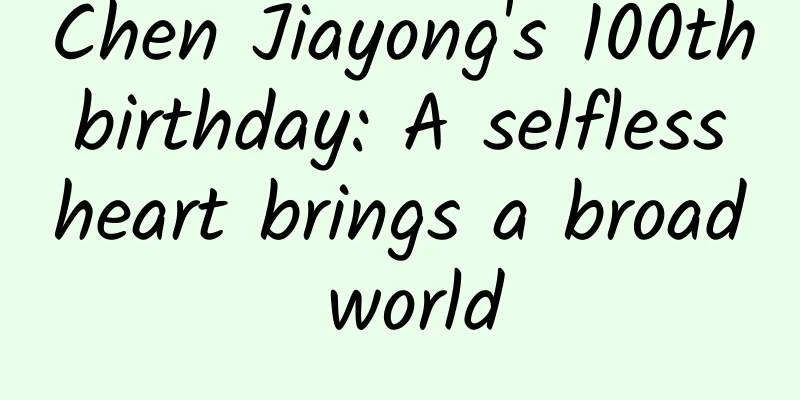Chen Jiayong's 100th birthday: A selfless heart brings a broad world

|
"The furnace fire illuminates the sky and the earth, and red stars are mixed with purple smoke." Metallurgy is always closely linked to fire. However, he took a different approach to metallurgical technology. Based on the actual situation of my country's mineral resources, he developed hydrometallurgical technology, combining modern chemical engineering techniques with metallurgy, which greatly improved my country's metallurgical efficiency. He is Chen Jiayong, an academician of the Chinese Academy of Sciences and the founder of my country's hydrometallurgy discipline. Chen Jiayong was born on February 17, 1922, and today is his 100th birthday. Dream of serving the country through science and technology Chen Jiayong was born in 1922 in an intellectual family in Jintang, Chengdu, Sichuan. In 1925, to avoid the war, his family moved to the ancestral house on Qinglong Street in downtown Chengdu. Chen Jiayong spent twelve years in Chengdu County High School and Chengdu County Middle School (now Chengdu No. 7 Middle School), not far from home. Being able to attend the best school in Chengdu at that time during the war-torn years, Chen Jiayong cherished the hard-won learning opportunity. He studied diligently and hard, treated people warmly and sincerely, and excelled in both academic performance and conduct. In 1947, Chen Jiayong went to the University of Illinois in the United States as a government-sponsored student to pursue a master's and doctoral degree. The head of the university's chemistry and chemical engineering department commented on him as follows: smart and studious, with a solid foundation, and hardworking and motivated. In May 1949, I installed the experimental equipment myself while doing my doctoral thesis "Determination of the carbon vaporization reaction rate" In the fall of 1952, Chen Jiayong, a postdoctoral student at the Massachusetts Institute of Technology, was invited by Professor H.F. Johnston of the University of Illinois to lead the research work on "Aerosol Filtration with Fiber Layers". Some of their results were published in the American "Chemical Reviews", which attracted attention from all sides. It was regarded as an authoritative summary of early scientific research in the field of aerosols (before 1955) and has been continuously cited to this day. Opening up new areas of hydrometallurgy In 1956, the Chinese and American governments reached an agreement, and the return of Chinese students was no longer blocked. Mr. Chen and his wife Liu Rong decided to realize their long-cherished wish and return to China with their two daughters. But just before they set off, a rude man suddenly broke into their home, claiming to be an "investigator" from the FBI, and asked provocative questions: "Have you ever been exposed to American state secrets?", "What are you bringing back home?", "Why do you want to go back to Communist China?", etc. Chen Jiayong, who had been prepared for this, was not in a hurry, responded calmly, and finally sent the rude man away. After returning to China, Mr. Chen Jiayong and Mr. Guo Musun were invited by Mr. Ye Zhupei to work as researchers at the Institute of Chemical Metallurgy, Chinese Academy of Sciences (the predecessor of the Institute of Process Engineering, Chinese Academy of Sciences). High-temperature smelting is a magic weapon left by our ancestors, and this "ancient method" is also called "fire method". However, "fire method" has great limitations. When encountering complex and difficult ore dressing, it is often "picking up sesame seeds and losing watermelons", and many precious minerals can only be treated as slag. During World War II, the need to refine uranium led to the emergence of "hydrometallurgy". It uses chemical solutions to leach minerals, and then uses extraction methods to separate useful metals. Because this method consumes less energy and has less pollution, it is particularly suitable for processing difficult-to-select, complex, and low-grade minerals. Since 1958, Chen Jiayong has served as the "Director of the Hydrometallurgical Research Laboratory" of the Institute of Chemical Metallurgy. This is the first hydrometallurgical research laboratory in China, and Chen Jiayong has therefore become a pioneer in hydrometallurgy in my country. From the late 1950s to the early 1960s, he combined the actual situation of my country's mineral and metallurgical industries to develop a number of advanced new hydrometallurgical processes, and many complex and difficult-to-select ores have since turned "waste" into treasure. Chen Jiayong combined modern chemical techniques with metallurgy, which greatly improved my country's metallurgical efficiency and achieved a qualitative leap in China's metallurgical technology. At the same time, he was also the earliest advocate and researcher of green chemical metallurgy in my country. He was the first to propose accelerating the sustainable development of chemical production and founded the Key Laboratory of Green Process and Engineering of the Chinese Academy of Sciences. The first microgravity chemical engineering application research attempted in my country's space history - the first microgravity chemical engineering experimental satellite was named after Chen Jiayong. It is a recognition of his outstanding achievements in the field of chemical engineering and a tribute to his dedication to the motherland in difficult times. In 1978, he attended the Chemistry Teaching and Research Group Meeting of the Graduate School of the University of Science and Technology of China (first from left: Chen Jiayong, third from right: Liu Dagang) Chen Jiayong was keenly aware that understanding the behavior of particles (including droplets, bubbles and solid particles) in multiphase chemical systems in macroscopic flow fields and concentration fields is an important basis for establishing the overall mathematical model of reaction and separation equipment. He did a lot of work and achieved gratifying results, contributing to the development of numerical simulation and scale-up technology for chemical reaction engineering in my country. Chen Jiayong also founded the Key Laboratory of Green Process and Engineering of the Chinese Academy of Sciences. Under the leadership of his student Yang Chao, he carried out international cooperation in the new field of microgravity chemical engineering, using artificial satellites to conduct pioneering applied basic research on chemical processes under microgravity conditions. Chen Jiayong often taught young people to "learn before knowing one's shortcomings", "know what you know and know what you don't know, that is true knowledge", and "seek truth from facts, don't cheat or rely on luck". His modest, prudent, strict and realistic style is a precious spiritual wealth left to future generations of students. In 1992, he gave a report at the Second International Hydrometallurgy Conference held in Changsha At home with my wife Chen Jiayong once said, "Since I was in the fifth grade of elementary school, I have been determined to work hard for the prosperity of the Chinese nation. Every step of my life is to fulfill my promise!" Now, he has done it. Comprehensive sources: Science and Technology Daily, Voice of the Chinese Academy of Sciences, Institute of Process Engineering, Chinese Academy of Sciences, Institute of Chemistry, Chinese Academy of Sciences, etc. |
<<: Drinking porridge to nourish the stomach? It may cause more harm to the stomach!
Recommend
[Brick Moving Arbitrage] Cute Rabbit Earns 100,000 Yuan a Year in Brick Moving Team, Episode 2
[Moving bricks for profit] Cute rabbit earns 100,...
A creative sharing of industry information flow advertising that you absolutely cannot miss
The general workflow of daily information flow ad...
8 common misconceptions about exercise, how many of them do you have?
These common habits related to exercise are actua...
User retention: How to improve user stickiness?
Do you remember the last time you vowed to stick ...
How to cancel a TikTok account? How to cancel a TikTok account?
This article mainly introduces how to cancel a Do...
Can regularly exposing your back to the sun help beautify your complexion and maintain your health?
The approach is unscientific. From a medical poin...
Kukaifeng Baocheng: OTT has a significant growth rate, and the advertising value will subvert traditional TV
Today, the "2017 China OTT Large Screen Mark...
How to choose the right shoes for running?
When running, a good pair of sports shoes is very...
The young man did not eat seafood or drink beer, but he got gout! It turns out that soda can also increase uric acid
Daqin, 28 years old, likes to drink beer and eat ...
Google Glass has failed? It seems too early to say
[[127642]] In January this year, Google shut down...
African children hold up signs and shout. How many words are required in the actual video of their shouting?
Please add customer service WeChat (Wechat): 1867...
31 Lessons on Introverted Children: The Best Way to Raise Them: Dare to Express, Be Creative, and Be Confident
Do you often worry about having an introverted ch...
Digging the root | Is picky eating a "bad habit"? Subverted! Picky eating may be a way for the immune system to protect the body!
gossip "If you don't eat, you won't ...
QQ unlimited group adding software + QQ group collection software_non-toxic software
QQ can be added to unlimited groups, and you can ...









